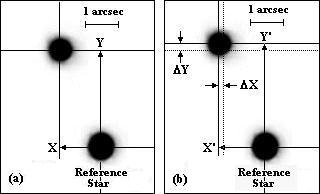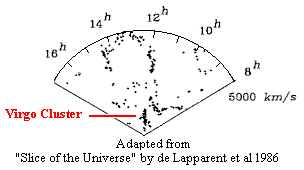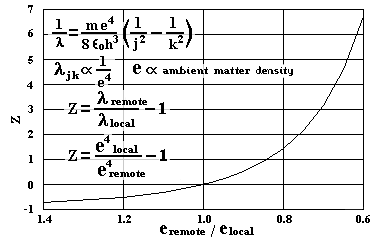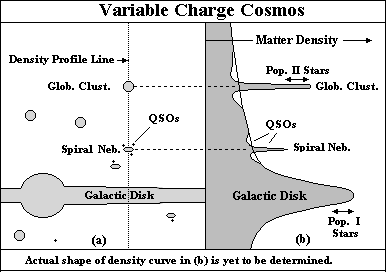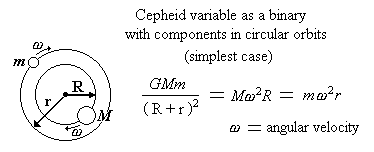Cosmology's Missing Mass Problems
Robert S. Fritzius
Shade Tree Physics
Text additions or changes are in bold.
Parts 1 - 7 have been incorporated into a single file.
This research has made use of NASA's Astrophysics Data System (NADS) Bibliographic Services.
The first Missing Mass Problem
*Visual equilibrium means that the amount of light (of stars) is proportional to amount of mass (number of stars).
In 1936 Sinclair Smith found similar evidence for the existence of invisible mass in the Virgo cluster. [An outline of the Virgo cluster can be seen in the lower left polar plot of the Star Map in Galactic Perspective]
In 1940 Oort estimated (based on the Mass-to-light ratio of spiral nebulae) that 90% of the mass in the local group of spiral nebulae is "missing." Oort didn't cite Zwicky's 1933 paper (BSVD).
The Second Missing Mass Problem
In 1970 Vera Rubin & Kent Ford, and in 1975; Roberts & White determined that the radial velocity curve plot (radius vs. velocity) for the Milky Way Galaxy flattens out rather than trailing down. The implication was that mass continues to increase with radius. Many other "galaxies" show the same effect. (BSVD)
It was commonly assumed that stars in galaxies would follow Kepler's laws like planets in the solar system. One of the earliest papers on this idea was published in 1927 by Bertil Lindblad, the newly appointed director of the Stockholm Observatory. (LB27) - NADS. [Added 15 Oct 2003.] Since the stars in the Milky Way galaxy and in spiral nebulae didn't follow Kepler's laws, then it was assumed that there was a whole lot of distributed invisible mass affecting them. (DJ)
Below is a diagram that demonstrates how Keplerian motions compare to the dynamics of stars in sparsely populated disk strutures that have no invisible masses. A computer program was used to model free-running Newtonian interactions between stars themselves and a Central Object (CO). Star masses, radii, and speeds are on arbitrary scales. All stars were assigned masses of 1.0, and in each run the mass of the Central Object was set to equal 32 stellar masses minus the summed mass of the stars in orbit. (The first run, with 4 stars and CO mass=28, (red curve) approximates Keplerian conditions. In the final run, with 32 stars, the mass of the CO was zero, and the blue curve resembles the radial velocity curves for big stellar disk systems. [Added 04 Jun 2010]
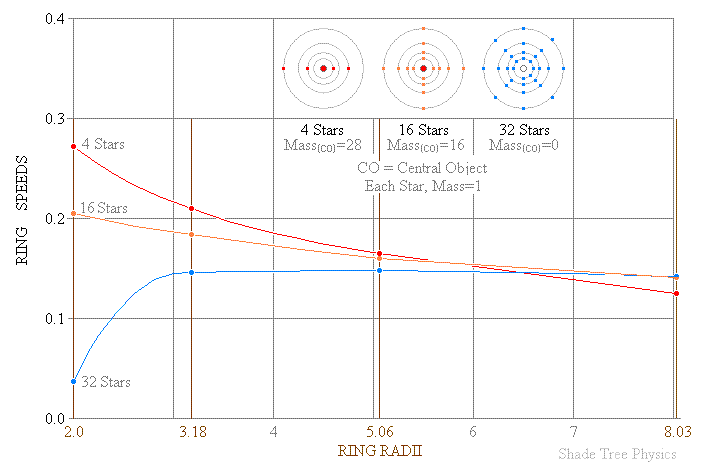
Stellar Linear Speeds versus System Configuration and Central Object Mass
In any given simulation run the initial speeds of the stars in each ring were set manually, so as to cause them to travel (for a while, at least) with nearly constant radii. Usually, after one or two orbits of the innermost star(s), the orbits begin gradually spiralling into one another and the traffic pattern becomes more and more like a square dance. Finally, they transition into a state of bedlam. I think this tendency toward disorder arises from not including magnetism in the modelling, i.e., gravitational interactions, by themselves, are incapable of leading to long term group stability. [Last sentence was added on 25 Aug 2012.]
The ring radii for these runs are 2.0, 3.18, 5.06 and 8.03 (The ratio between adjacent ring sizes is 1.59:1.) [Added 31 May 2010. The graph and descriptive material were moved here from Part 2 on 04 Jun 2010.]
Where the author is going in this article
A brief outline of most of the missing mass explanations, with links to internet sources of more in-depth information is provided. But then, the article will move on to what the author considers to be the real problems (and what to do about them).
First Proposed Solutions to Missing Mass Problem
(Including some "known" or suspected problems in selected cases)
The basic outline for this section is derived from the articles Dark
Matter versus MOND
URL was http://www.astro.umd.edu/~ssm/mond/mondvsDM.html (DMVM), and
What is the Missing Mass problem? Science Net - Physics (SNP). URL was at
http://www.sciencenet.org.uk/database/Physics/Cosmology/p00717c.html.
Other sources are identified as appropriate. This list is under construction.
CDM (Cold Dark Matter)
WIMPs (Weakly Interacting Massive Particles) (SNP)
These move slowly.
Axions, 6-15 Mev?, Seishi Matsuki ca 1983 - None visualized yet. -
(SMKU)
Massless neutrinos
(CXO)
Photinos
(CXO)
Neutralinos
(DJ) [Link to www.astro.queensu.ca no longer works.]
No WIMPS detected yet.
(CXO)
Hydrogen Gas - Difficult for it to hide.
(CXO)
WDM (Warm Dark Matter) - Baryonic
Warm Intergalactic Fog -
(NF03) - The Jury is out. -
[Added 16 August 2003.]
HDM (Hot Dark Matter) -Non-Baryonic (SNP)
(Hot, means traveling at or near the speed of light.)
Neutrinos - If their mass was = 92 eV it would make Omega = 1.0
(DJ)
Link to (DJ) was: http://www.astro.queensu.ca/~dursi/dm-tutorial/dm0.html
Apparently Neutrinos have mass but not enough to fit the bill. (SNP)
The author's Sub-quantum Positive and negative chargelets
(FR93) would fit
into the HDM category, but he is of the opinion that trying to capture
them
is equivalent to trying to capture virtual photons. He does, however,
apply
them to the missing mass problem. See A Variable Charge Explanation for
Cosmological Redshift in Part 6 of this article. [Added 21 Jan 2004.]
BDM (Baryonic Dark Matter)
MACHOs (Massive Astronomical Compact Halo Objects)
(SMKU)
Dead stars/white dwarfs, in galactic halo
(BBCN)
(SMKU)
but
Not enough helium, which should accompany white dwarfs.
(CXO)
Brown Dwarves (Dwarfs) / Jupiters - Not enough of them.
(CXO)
Red Dwarfs - Not enough of them.
(SEV94) -
[Added 3 Aug 2003.]
Neutron Stars - Scarcer than white dwarfs -
No evidence of released energy and heavy elements.
(CXO)
Unborn stars
(SMKU)
Black Holes
(SMKU)
(CXO)
Predicted by Einstein's GTR
Interloper galaxies may account for all the missing mass.
(DJ)
Both CDM and HDM have their problems; HDM can't form small structures like galaxies, and CDM has problems forming large scale structure (DJ)
Other ways of looking at the problem
Quantum Gravity
A distortion in the quantum vacuum energy leads to an additional "Bubble Force"
which may explain the constant galactic-rotation curves. (NRV)
But.... the Hubble Space Telescope is taking pictures that are too clear.
They show no evidence of the hazy effects that quantum foam should produce.
Looks like trouble for quantum foam and hence quantum gravity. ( BR03)
Peebles ICDM (Isocurvature Cold Dark Matter) model (PICDM-1, PICDM-2)
"[T]he BOOMERANG measurement of the height and the position of the
first "acoustic peak" in the CMB fluctuations has ruled out the IDCM
model as it was originally proposed." - (MW02)
Conformal Weyl gravity (No details)
Non-symmetric gravity (No details)
MOND (Modified Newtonian Dynamics)
One proponent of MOND says that all of the dark matter theories fail. (MS1)
Link to (MS1) was http://www.astro.umd.edu/~ssm/mond/mondvsDM.html.
See the MOND section below.
Inertial Induction (Noriaki Namba) (NN02)
Stars are hypothesized to exert inertial induction on each other which tends to
produce coherent group accelerations. This coherence tendency leads to constant
rotation speeds in the outer regions of rotating stellar systems, the Milky Way
galaxy for example. [Added 20 April 2004.]
Electrodynamic Considerations
Plasma cosmology (Hannes Alfvén) (No Ref.)
Electric Stars (Ralph Juergens) (No Ref.)
These models complement one another.
Large-scale electrodynamic processes
moderate the interactions between stars
and lead to "group transport" behavior
along the lines of fluid dynamics).
Part 2
New Force Laws
MOND is a modification of the usual Newtonian force law, hypothesized in
1983 by Moti Milgrom of the Weizmann Institute, as an alternative to
Dark Matter. It explains the flat rotation curves of some*
spiral galaxies without resorting to the use of dark matter. It applies
to Dwarf and Low Surface Brightness galaxies only.
(MS2) (NADS)
*(Acceleration is critical factor - Low acceleration disk galaxies needed.)
MOND can be interpreted as either a modification of gravity through a change to the Poisson equation, or as a modification of inertia through a breaking of the equivalence of inertial and gravitational mass. (It's basically a mathematical exercise.) The modification occurs at very small accelerations.
Stacy McGaugh, a proponent of MOND, says "MOND is difficult to test, and does not constitute a falsifiable theory." (MS1). With that in mind, we move on to new territory.
Chandra observations of the hot gas halo of NGC 720 (a flattened gas
distribution) is not consistent with the MOND predictions.
(NNR02)
- Was http://www1.msfc.nasa.gov/NEWSROOM/news/releases/2002/02-264.html
Soap-Box Statement
Einstein's equations of GTR did not permit a static universe. The Universe
must either be expanding or contracting. The de Sitter solution to the
GTR equations predicted an expanding universe.* De Sitter is also
the mathematician who almost buried the ideas of Einstein's
biggest competitor on relativity theory, Swiss Physicist Walter Ritz.
See: (SV87)
The author happens to be a fan of Ritz's Newtonian-like electrodynamics,
some of which can be seen at (RW08).
*(This statement may need some modifications. Checking! - 17 July 2003)
The Friedman-Lemaitre Standard Cosmological Model (which came to be accepted as a fix to GTR) also predicts an expanding universe. Hubble's increasing redshifts for galaxies at greater and greater distances came to be interpreted as being evidence of the required expansion of the universe, and thus the Big Bang came to be the paradigm.
The author contends that cosmological redshift, as a velocity/distance indicator, has led to a universe whose size is grossly overestimated, and that the inflated "scale of the universe" has contributed to the first of the missing mass problems. Such a view demands a re-interpretation of cosmological redshift. The author's re-interpretation will be respectfully offered for consideration. [Modified 18 Mar 2006.]
The second ... missing mass problem (the flat rotation velocity curves of galaxies/spiral nebulae) is hypothesized to be related to our failure to take into account the electrodynamic interactions of moving interstellar plasma as it affects the group transport of visible galactic matter (stars and gases). This paper will not dwell on the electrodynamic interactions just mentioned, but astrometric evidence consistent with flat galactic velocity curves was copiously published in the early part of the twentieth century. That evidence came to be rejected by mainstream cosmologists. The author maintains that the real reason for the rejection (of the astrometric evidence) was because the evidence was ... contrary to the growing consensus regarding the idea of a large expanding universe. This article calls for renewed attention to the rejected evidence. [Paragraph was "tweaked" on 1 August 2003.}
The Shapley-Curtis Debate (SC21)
Words inserted into these quotes, to clarify matters, are enclosed in [square brackets].This procedure will be used in other quotations below.
By 1920, the nature of spiral nebulae had become one of the major questions in astronomy. The National Academy of Sciences organized a Scale of the Universe debate on the topic between Harlow Shapley and Heber Curtis.
Shapley defended the "conventional" view that spiral nebulae were objects associated with the galaxy, rather than large, independent stellar systems. (He did want a bigger Milky Way; 300,000 light-years in diameter.)
At that time the estimates for the diameter of "our" galaxy ranged from 7,000 to 60,000 light years. (SC21)
Curtis wanted to restrict the diameter of the Milky Way to about 30,000 light-years, and championed the hypothesis of a large universe in which spiral nebulae were independent stellar systems, e.g., other island universes.
Among Shapley's arguments:
"Another consequence of the conclusion that the galactic system is of the order of
300,000 light-years in greatest diameter, is the previously mentioned difficulty it gives
to the 'comparable-galaxy' theory of spiral nebulae. I shall not undertake a description and
discussion of this debatable problem. Since the theory probably stands or falls with the
hypothesis of a small galactic system, there is little point in discussing other material on
the subject, especially in view of the recently measured rotations of spiral nebulae which
appear fatal to such an interpretation."
Curtis had difficulty dealing with Shapley's proposed 300,000 light-year diameter galaxy. In his words:
"If the spirals are island universes it would seem reasonable and most probable to assign
to them dimensions of the same order as our galaxy. If, however, their dimensions are
as great as 300,000 light-years, the [other] island universes must be placed at such enormous
distances that it would be necessary to assign what seem impossibly great absolute magnitudes
to the novae which have appeared in these objects."
(SC21)
Currently, the galaxy is thought to be about 110,000 light-years in diameter,
[roughly four times larger
than Curtis wanted but about one third the
diameter estimated by Shapley.] with the solar system being
about 30,000 light-years from the center. (DT71) p. 290)
Here are some further thought provoking remarks that Curtis made with
respect to spirals.
From (SC21)
Many edge-on spirals show a dark, obscuring belt in the middle of the disk. A similar belt
in the Galaxy would explain why spiral nebulae aren't seen near the plane [of our galaxy].
Most spiral nebulae have large radial velocities, [based on their redshifts] so they would
probably escape from the Galaxy's gravity. [This is what lead Zwicky and later researchers
to postulate missing mass.]
"The spirals are found in greatest numbers just where the stars are fewest (at the galactic
poles), and not at all where stars are most numerous (in the galactic plane).... No spiral
has yet been found actually within the structure [within the confines of the disk] of the
Milky Way."
"Their abhorrence of the regions of greatest star density can only be explained on
the hypothesis that they are, in some unknown manner, repelled by the stars [in our galaxy]."
"Why should this repulsion have invariably acted essentially at right angles to our galactic plane?"
"Why have not some been repelled in the direction of our galactic plane?"
"Should the results of the next quarter-century show close agreement among different
observers to the effect that the annual motions of translation or rotation of the spirals
equal or exceed 0.01 arc-seconds in average value, it would seem that the island
universe theory must be definitely abandoned."
This last remark seems to be in reference to van Maanen's work, who had been regularly reporting annual spiral rotations on the order of 0.02 arcseconds, and in one case as high as 0.038. (Curtis didn't mention van Maanen by name.)
"It is improbable that our galaxy should, by mere chance, be placed about half way
between the two great groups of island universes."
Here, he was getting close to admitting a Copernican problem, i.e., a special position for us in the universe.
"Their space velocity [based on redshifts?] is one hundred times that of the galactic
diffuse nebulosities, about thirty times the average velocity of the stars, ten times that
of the planetary nebulae, and five times that of the clusters."
Part 3
Adriaan van Maanen's Evidence for a Small Universe
(Or, Five Pounds of Stuff for a Five Pound Bag)Adriaan van Maanen's monumental work on of spiral nebulae, as it stood in 1921, offers a long overlooked (read "rejected") solution to the flat rotational velocity curves for "galaxies." In the author's opinion, van Maanen's investigations have been wrongfully relegated to oblivion. Evidence will be presented below to hopefully help rectify the situation, and to commend van Maanen's findings as an already-accomplished solution to one half of the missing mass problem.
From 1916 through 1927 van Maanen, who was a recognized authority on precision astronomical position measurements, produced twelve papers dealing with astrometrically determined internal motions of spiral nebulae. Shapley used his findings as ammunition in the great debate, but later on lost the faith in a groundswell of criticism directed at van Maanen's findings.
In his 1921 paper on the spiral nebula M 81, van Maanen summarized his findings on the internal motions of four spirals, M33, M51, M81 and M101. He states,
"As in the case of M101, 33, and 51, there is a question as to whether the
[nearly circular]
displacements [of M 81] are best represented by a rotation or by a motion
along the arms
of the spiral.
(MA21)
See the tabular summary: Internal Proper Motions for
M101, M33, M51 and M81.
[Added 27 July 2003.]
According to van Maanen, this motion of matter along the arms was river-like, i.e., gaseous and/or unresolved-stars spiraling outward in stream-like fashion.
See: Messier 81 Internal Motions.
(Added 19 July 2003.)
Messier 33 Internal Motions.
(Added 9 June 2005.)
For each of the spirals he subtracted the average proper motion (in milliarcseconds per year) of the spiral from the measurements for individual data points to arrive at his rotational versus stream angular displacements.
He divided his measured displacements by the number of years between photographs to obtain the annual rates for angular displacements.
There is no direct information in van Maanen's 1921 paper (MA21) that identifies his estimated sizes of, or the distances to, the spirals, but if we assume, with Curtis, that the spirals should have similar tangential linear rotation speeds to our own, i.e., 320 km/sec at our location in the Milky Way disk, and use that speed to convert van Maanen's rotational periods to spiral diameters, we get the following results.

Table 1
These "starting point" spiral diameters are quite contrary to Curtis' idea for other island universes, where diameters on the order of 30,000 light-years were desired. That kind of information had to be available to his colleagues, and van Maanen's train was headed down the wrong track!
The average of recent spectroscopic determinations of rotational velocities for the four objects in Table 1 is 178 km/sec. That's within a factor of two of the 320 km/sec starting point velocity used above. See Table 2.
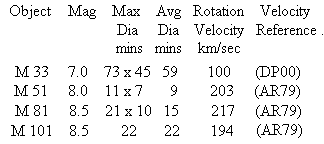
Table 2
A Cornell University astronomy course webpage shows an edge-on rotation curve for the spiral "galaxy" UGC 9242. The Doppler shift rotation velocities, in the "flat" part of the curve, vary from 195 to 235 Km/sec, and average approximately 220 Km/sec. [Added 8 Aug 2003.]
Table 3 shows how van Maanen's linear proper motions for a very limited sample of spirals and globular clusters compared to other astronomical objects.
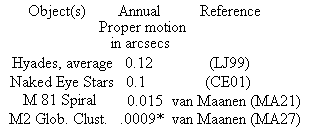
Table 3
In their paper Internal Motions in Globular Clusters (KA00), King and Anderson report astrometric measurements of internal proper motions in globular cluster 47 Tucanae, using HST's WFPC2 camera with photographic epochs separated by two years. In 47 Tuc, the dispersion of internal proper motions has been found to be about 0.6 milli-arcsec/year in each coordinate. URL for (KA00) was http://arxiv.org/PS_cache/astro-ph/pdf/0007/0007028.pdf.
Referring back to a radial velocity study of 47 Tuc (Meylan & Mayor 1986, get ref.) which showed evidence of rotation of the cluster, King and Anderson report "We can in fact see rotation clearly in the proper motions too..." [No quantitaive value given yet.]
Based on asymmetry [a slight flattening] found in several globular clusters (Pease and Shapley), Van Maanen (MA27) stated "...it follows that the motions resulting from a possible rotation of the clusters are small. Tangential components of the motions are derived therefore only because evidence of such motions had been found in the measures of spiral nebulae." [Emphasis added.]
Van Maanen's findings included the following. For the plates taken at the 25-foot focus of the Mt. Wilson 60-inch reflector, the mean [internal proper motion] tangential component for globular clusters M 13 and M2 was 3 milli-arcsecs/year, compared to the average for seven spirals of 18.4 milli-arcsecs/year.
Comparing findings from 47 Tuc to those of M13 and M2 is not quite the same as comparing apples and oranges, but it does leave much to be desired. Even so, King and Anderson's 0.6 milli-arcsecond/year dispersion for 47 Tuc and van Maanen's 3 milli-arcsecond/year average tangential component for M13 and M2 are within a factor of ten-to-one of another. It might be worthwhile to bring HST's astrometric capabilities to bear on one or both of these latter objects.
[Added 10 August 2003.]
The proper motions of Quasi-Stellar Objects (QSOs) that the author has found so far, have mostly been attributed to gravitational lensing by intervening objects. It will be of interest to see if the gravitational lenses (which have to be moving in order to induce apparent QSO proper motions) move on, and let the QSOs return to their stationary outposts.
The following comments are from van Maanen's 1921 paper. (MA21) Certain words or phases have been italicized or bolded for emphasis.
For M 101 there is no appreciable change in the measured rotational
component
with distance from the center, but for M 33, 51, and 81 there appears to be
some
increase of [rotational] motion with distance."
Was 1970 a year for echoes - a' la flat galactic-rotation curves?
"In all cases, however, the measured displacements agree better with the
hypothesis of
outward motion along the arms of the spiral than they do with an
assumed rotation
of the nebulae as a whole."
Those colleagues of van Maanen who were pushing for an expanding universe,
were "unable" to repeat his findings. They dismissed his work as it being
a case of his finding what he wanted to find. One of the primary, and
often repeated, (and to this writer, fallacious) criticisms levied against
van Maanen was that the precision of his measurements was smaller than
normally encountered measurement errors. He was said to be reading
positional variations much smaller than the sizes of the atmospherically
blurred photographic images. References
(BA02),
(GK02),
(IU), and
(TV95)
provide evidence of how his work was demeaned.
URL for (BA02) was http://nchalada.org/archive/WaveLng21.html.
URL for (IU) was http://physics.syr.edu/courses/AST104.99Spring/Island.htm
Here's a quote from the first of the four references above. It is typical of the precision arguments made against van Maanen. The quote is taken from Andrew Bell's section on Suggested Discussion Topics (Part II) under the second sub heading of Achievable precision. The other three references are left to the reader.
